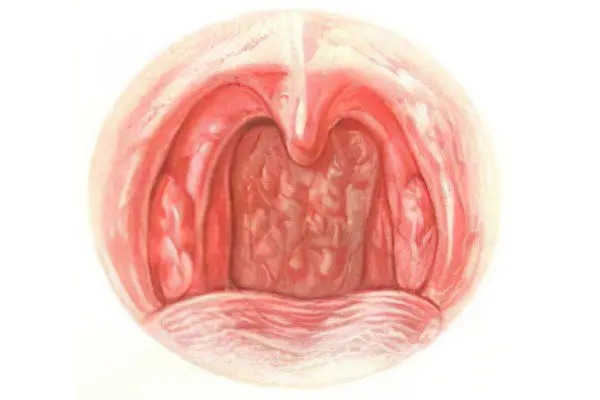Contents
catarrhal pharyngitis – This is an inflammation of the mucous membrane of the throat, which is accompanied by increased formation of viscous thick mucus, perspiration and discomfort in the throat. Catarrhal pharyngitis can be acute or chronic. The disease is widespread in all age groups and has a different origin. So, it is the catarrhal form of acute pharyngitis, which develops against the background of a viral infection, and is the most common form of acute sore throat. Due to the fact that catarrhal pharyngitis most often proceeds quite easily, it is also called simple pharyngitis.
Causes of catarrhal pharyngitis

The causes of catarrhal pharyngitis are diverse, almost any irritation of the mucous membrane of the throat can lead to the development of inflammation.
The following disease provocateurs are distinguished:
Viral infection of the mucous membrane of the throat. It has been established that about 70% of all catarrhal pharyngitis develops against the background of viral infection. Dangerous in this regard are rhinoviruses, coronaviruses, adenovirus, influenza virus, etc.
Bacterial infection of the mucous membrane of the throat. Streptococci, staphylococci, Haemophilus influenzae, etc. can provoke the disease. Most often, in patients with a bacterial form of catarrhal pharyngitis, several colonies of pathogenic microorganisms are sown at once.
Fungal infection of the mucous membrane of the throat. The danger is represented by fungi of the genus Candida and filamentous fungi. Fungal infection of the posterior wall of the throat develops most often with irrational therapy with antibacterial drugs, which causes a persistent dysbiotic change in the normal microflora of the mucosa.
The age of the patient also matters in terms of determining the cause of inflammation. It has been established that in elderly people the composition of the microflora of the mucous membrane of the throat changes towards an increase in such microorganisms as Staphylococcus aureus and gram-negative enterobacteria. Therefore, senile catarrhal pharyngitis is isolated separately.
Allergens can provoke the development of persistent inflammation of the throat.
Catarrhal pharyngitis can be of traumatic origin and result from mechanical trauma when a foreign object enters the throat. Surgery can also cause the development of the disease. No less dangerous are thermal and chemical damage to the mucous membrane of the throat.
Violations of immune defense, hypothermia, severe chronic diseases are factors provoking the development of the disease.
Smoking and the intake of strong alcohol negatively affect the condition of the throat.
The air inhaled by a person matters. Thus, the risk of developing the disease increases when living in ecologically unfavorable areas, when working in hazardous industries.
Diseases of the digestive system are often the cause of the development of catarrhal pharyngitis, as long-term irritation of the mucous membrane of the throat with acidic gastric contents occurs. In this regard, such pathologies as gastroesophageal reflux, gastritis, gastric ulcer, hiatal hernia represent a danger.
The presence of a chronic focus of infection in the body often provokes the development of pharyngitis. It can be sinusitis, tonsillitis, rhinitis, otitis, etc. No less dangerous is dental caries.
Symptoms of catarrhal pharyngitis
Symptoms of catarrhal pharyngitis do not bother the patient too much, but it is impossible not to notice them:
The main complaint of patients is discomfort in the throat. It manifests itself in perspiration, itching, burning.
There may be pain when swallowing food and liquids. The pain is usually symmetrical.
Body temperature with catarrhal pharyngitis remains within the normal range, but can reach subfebrile values. Fever develops more often with bacterial pharyngitis of streptococcal etiology.
Palatine tonsils, palatine arches, the back wall of the pharynx swells, turns red.
On the tonsils and on the back of the throat, plaque can be visualized.
There is a sensation of a foreign body in the throat. This is due to the fact that viscous mucus is constantly produced by the inflamed glands.
The patient tries to clear this mucus from the throat by coughing.
Possible hoarseness of voice.
Often catarrhal pharyngitis is combined with rhinitis, sometimes symptoms of conjunctivitis join.
Diagnosis of catarrhal pharyngitis
Diagnosis of catarrhal pharyngitis is primarily to distinguish between the viral and bacterial nature of the disease. Based only on the clinical course of inflammation, it is quite problematic to do this. Therefore, in addition to standard pharyngoscopy, a smear is taken from the palatine tonsils and the back of the throat for bacteriological culture. The preliminary result can be obtained a day after the smear is taken, and the final result – after 2-3 days.
Treatment of catarrhal pharyngitis

Treatment of catarrhal pharyngitis is carried out on an outpatient basis and does not require hospitalization. It is built on the basis of the cause that led to the development of inflammation.
Antibacterial therapy is prescribed only if a bacterial causative agent of pharyngitis is identified. Statistics show that 20-30% of children and no more than 15% of adults need antibiotics. The drug of choice is penicillin (Phenoxymethylpenicillin), since it is to it that the most common causative agent of bacterial pharyngitis, beta-hemolytic streptococcus, is sensitive. If the drug is ineffective, then it is possible to prescribe 2-3 generation cephalosporins (Cefixime, Ceftibuten), or macrolides (Erythromycin, Azithromycin, Clarithromycin).
If a mycotic infection is suspected, the patient is prescribed Fluconazole orally for up to 2 weeks. If therapy is ineffective, then the drug is replaced with Itraconazole or Ketoconazole.
Often, symptomatic treatment is sufficient for the treatment of catarrhal pharyngitis. The patient is prescribed a sparing diet, the use of foot baths with hot water, steam inhalations. It is important to stop smoking during treatment.
Useful gargling sea water (Aqua Maris) or isotonic solution (200 ml) with the addition of 5 drops of iodine 5% concentration. This allows not only to wash off viruses and bacteria from the back of the throat and tonsils, but also makes it possible to remove inflammation and swelling from them.
Also, decoctions of herbs (chamomile, sage) are used for gargling. Local antiseptics include iodine preparations (Lugol, Yoks) and propolis (Proposol), Miramistin, Chlorhexidine, Ingalipt, Biclotimol, Fusafungin, Gramicidin C, Tantum Verde, etc.
With an increase in body temperature, the patient is prescribed medication from the NSAID group.
Timely treatment of catarrhal pharyngitis leads to a complete recovery of the patient with the normalization of the functioning of the mucous membrane of the throat.









